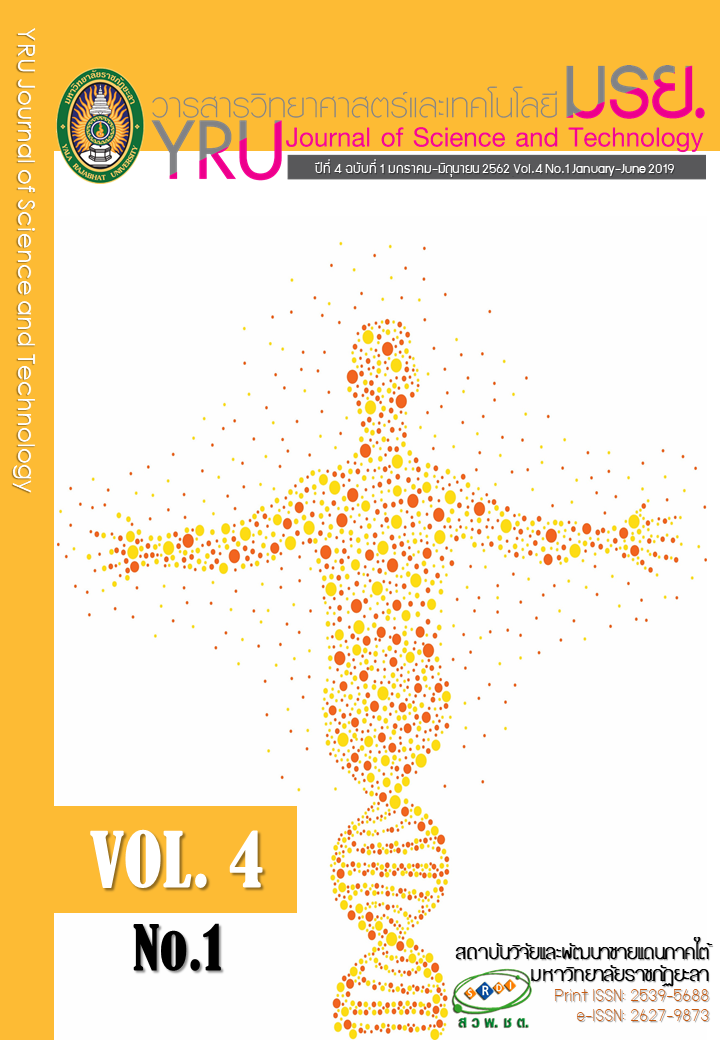Landmark-based Geometric Morphometric Analysis of Wing Venation between Two Libellulid Species, Brachythemis contaminata and Diplacodes trivialis
Main Article Content
Abstract
In this current research, a discrimination of two distinguished dragonfly species: Brachythemis contaminata and Diplacodes trivialis in family Libellulidae gathered from Phichit-Phitsanulok areas was conducted using geometric morphometric analysis of wing venation. A total of 120 wings obtained from both males and females in each species (30 wings per sex in each species) were analyzed. Afterwards, a set of 15 landmarks in each digitized right forewing was chosen and all data were computed under the computer program. Our results revealed the patterns of forewing venation of dragonfly between sexes in the same species were more closely related to each other than the dragonfly of the same sex in another species. In this regards, it might be said that the landmark-based geometric morphometrics of the wing could be applied to identify libellulid group or species. Besides, the different sexes of dragonfly could be also classified. Thus, morphometric analysis of wing venation could be as a useful tool for systematic biology of dragonfly and other insects or fossil records which are merely known from a wing.
Article Details
บทความ ข้อมูล เนื้อหา รูปภาพ ฯลฯ ที่ได้รับการเผยแพร่ในวารสารวิทยาศาสตร์และเทคโนโลยี มรย. นี้ ถือเป็นลิขสิทธิ์ของวารสารวิทยาศาสตร์และเทคโนโลยี มรย. หากบุคคลหรือหน่วยงานใดต้องการนำทั้งหมดหรือส่วนหนึ่งส่วนใดไปเผยแพร่ต่อหรือกระทำการใดๆ จะต้องได้รับอนุญาตเป็นลายลักษณ์อักษรจากวารสารวิทยาศาสตร์และเทคโนโลยี มรย. ก่อนเท่านั้น
References
2. ทิพย์วรรณ สรรพสัตย์ และมณฑกานต์ บุญหิน. (2557). ความผันแปรในปีกชันโรง Tetragonilla collina บนพื้นฐานของการวิเคราะห์ทางมอร์ โฟเมตริกและเรขาคณิตสัณฐานวิทยา. ในวารสารการประชุมครั้งที่ 4 : อนุกรมวิธานลซิสเทมาติคส์ในประเทศไทย, คณะวิทยาศาสตร์, มหาวิทยาลัยนเรศวร. หน้า 37-45.
3. พิสุทธิ์ เอกอำนวย. (2541). แมลงปอของไทย. (พิมพ์ครั้งที่ 2). กรุงเทพฯ : บริษัท บี พริ้นติ้งกรุ๊ปจำกัด
4. เสาวลักษณ์ ตอโนนสูง. (2555). ความผันแปรทางสัณฐานวิทยาของปีกชันโรงสกุล Ttigona. การศึกษาอิสระ. พะเยา : คณะวิทยาศาสตร์ มหาวิทยาลัยพะเยา.
5. Benke, A. C. & Benke, S. S. (1975). Comparative Dynamics & Life Histories of Coexisting Dragonfly Population. Ecology, 56, 302-317.
6. Blois, C. (1985). Diets & Resource Partitioning between Larvae of Tree Anisopteran Species. Hydrobiologia, 126, 221-227.
7. Carle, F. L. (1979). Environmental Monitoring Potential of the Odonata, with a List of Rare & Endangered Anisoptera of Virginia, United States. Odontologica, 8, 319-323.
8. Corbet, P. S. (1999). Dragobflies: Behaviour & Ecology of Odonata. Colchteesr: Harley Books.
Crowley, P. H. & Johnson. 1982. Habitat and Seasonality as Niche Axesin an Odonata Community. Ecology, 63, 1064-1077.
9. Daly, H. V. (1985). Insect Morphometrics. Annual Review Entomology, 30, 415-438.
10. Demayo, C. G., Harun, S. A. & Torres, M. A. J. (2011). Procrustes Analysis of wing Shape Divergence among Sibling Species of Neurothemis Dragonflies. Australian Journal of Basic and Applied Sciences, 5(6), 748–759.
11. Hennig, W. (1981). Insect Phylogeny. Translated and Edited by Adrian C. Pont, Revisionary Notes by Dieter Schlee and 9 Collaborators. New York: John Wiley and Sons.
12. Johnson, D. M. (1991). Behavioral Ecology of Larval Dragonflies and Damselflies. Trends in Ecology and Evolution, 6, 8–13.
13. Johnson, L., Mantle, B. L., Gardner, J. L. & Backwell, P. R. Y. (2013) Morphometric Measurements of Dragonfly Wings: The Accuracy of Pinned, Scanned and Detached Measurement Methods. ZooKeys, 276, 77–84.
14. Kumar, A. (1996). A Comparative Study on Stomach – Content & Forage Ratio of Zygoptera & Anisopteran Larvae in a Fish Pond of Santhal Pargana (Bihar), India. Proc. Natl. Acad. Sci. India. B. Biol. Sci, 66, 315-321.
15. Lee, Y. H. & Lin C. P. (2012). Morphometric and Genetic Differentiation of Two Sibling Gossamer–Wing Damselflies, Euphaea formosa and E. yayeyamana, and Adaptive Trait Divergence in Subtropical East Asian islands. Journal of Insect Science, 12(53), 1-17.
16. Mahato, M. (2000). Resource Partitioning among Larvae of Six Coexisting Odonate Spices of the Kali Gandaki River, Central Napal (Anisoptera). Odontologica, 29, 209-233.
17. Rattanawannee, A., Chanchao, C & Wongsiri, S. (2010). Gender and Species Identification of Four Native Honey Bees (Apidae: Apis) in Thailand Based on Wing Morphometic Analysis. Entomological Society of America, 103(6), 965-970.
18. Rattanawannee, A. Jeratthitikul, E, Duangpakdee, O & Oldroyd, B. P. (2017). Mitochondrial Sequencing and Geometric Morphometrics Suggest Two Clades in the Tetragonilla collina (Apidae: Meliponini) Population of Thailand. Apidologie. 1-13.
19. Rohlf, F. J. (2010a). tpsDig. Version 2.04. Ecology & Evolution. USA: State University of New York at Stony Brook.
20. Rohlf, F. J. (2010b). tpsRelw. Version 1.49. Ecology & Evolution. USA: State University of New York at Stony Brook.


